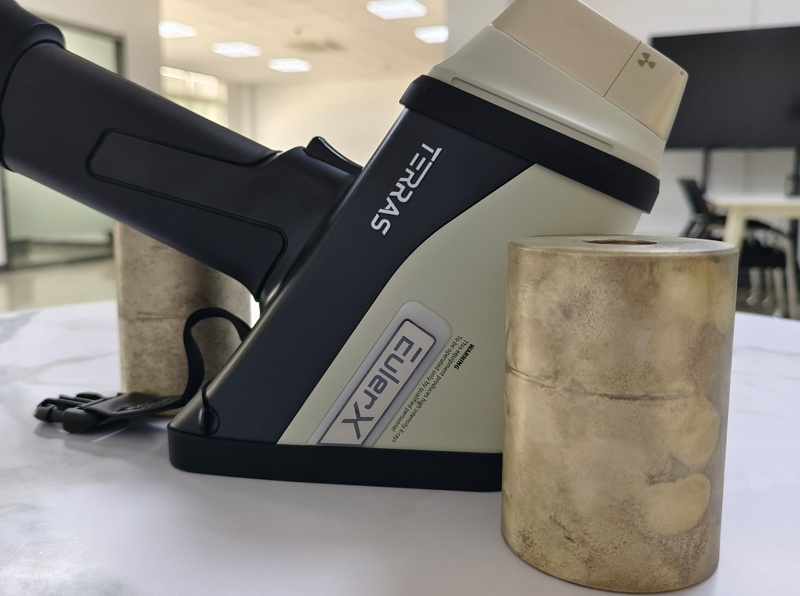
Metal Material
A high-tech enterprise focusing on the development and application of X-ray technology products, committed to becoming a leading supplier of X-ray industrial testing solutions.
A Comprehensive Guide to Using a Handheld XRF Analyzer for Metal Testing
Handheld X-ray fluorescence (XRF) analyzers have revolutionized metal testing across industries, from scrap recycling to aerospace manufacturing. These portable devices provide instant, non-destructive elemental analysis, making them indispensable for quality control, material verification, and compliance testing.
Whether you're new to XRF technology or looking to optimize your testing process, this guide will walk you through how to use a handheld XRF analyzer for metal testing, including best practices, applications, and tips for accurate results.

1. How Does a Handheld XRF Analyzer Work?
XRF analyzers detect the unique fluorescent X-rays emitted by a material when exposed to X-ray beams. By measuring these emissions, the device identifies:
Key Components of an XRF Analyzer:
✔ X-ray tube – Generates excitation X-rays
✔ Detector (SDD or PIN diode) – Captures fluorescent signals
✔ Software – Analyzes data and displays results
✔ Touchscreen interface – For user control
2. Step-by-Step Guide to Metal Testing with XRF
Step 1: Prepare the Sample
Clean the surface – Remove dirt, paint, or coatings that could interfere with readings.
Use a flat area – Ensure good contact between the analyzer and the sample.
For small/thin samples, place them on a stable, non-reflective surface.
Step 2: Position the Analyzer Correctly
Hold the XRF gun perpendicular to the sample.
Maintain a consistent distance (typically 1-2 mm gap for optimal readings).
Use the trigger or touchscreen to start the scan.
Step 3: Select the Right Testing Mode
Most XRF analyzers offer different modes:
Alloy Mode – For metal identification (e.g., stainless steel, aluminum, brass).
Mining Mode – For ore and mineral analysis.
RoHS Mode – Detects hazardous elements (Pb, Cd, Hg, etc.).
Step 4: Analyze & Interpret Results
The analyzer displays elemental composition in seconds.
Compare results against industry standards (e.g., ASTM, ISO).
Save or export data for quality records and compliance reports.
3. Common Applications of XRF Metal Testing
✔ Scrap Metal Recycling
Sort ferrous & non-ferrous metals quickly.
Detect impurities (e.g., copper in aluminum).
Verify alloy grades for accurate pricing.
✔ Manufacturing & Aerospace
Incoming material inspection (avoid counterfeit metals).
Weld verification (check filler metal composition).
Quality control for automotive parts.
✔ Jewelry & Precious Metals
Verify gold, silver, and platinum purity.
Detect counterfeit metals (e.g., gold-plated tungsten).
✔ Mining & Exploration
On-site ore grade analysis.
Identify valuable elements (e.g., Au, Ag, Cu).
4. Best Practices for Accurate XRF Testing
✅ Calibrate Regularly – Follow the manufacturer’s guidelines.
✅ Use Certified Reference Materials (CRMs) – To validate accuracy.
✅ Avoid Thin or Coated Samples – Thicker samples (>1mm) give better results.
✅ Test Multiple Spots – Ensure homogeneity in the material.
✅ Follow Safety Protocols – Use the analyzer in a well-ventilated area.
6. Choosing the Right XRF Analyzer for Metal Testing
When selecting a handheld XRF gun, consider:
Detection range (elements needed for your industry).
Accuracy & speed (SDD detectors for better resolution).
Durability (IP54 or higher for rugged environments).
Software features (data export, alloy libraries).

Terras EulerX900 Handheld Alloy Analyzer
The EulerX 900 handheld XRF analyzer revolutionizes metal testing with instant, accurate composition analysis. Designed for ease of use, it identifies alloys, verifies materials, and sorts scrap effortlessly—handling solids, liquids, and powders without prep. Its advanced tech ensures reliable quality control in seconds.
Conclusion
A handheld XRF analyzer is a fast, accurate, and portable solution for metal testing across industries. By following proper testing techniques and best practices, you can maximize efficiency, ensure compliance, and make informed material decisions.
Join Us
Subscribe to our email list for updates & promotions.



